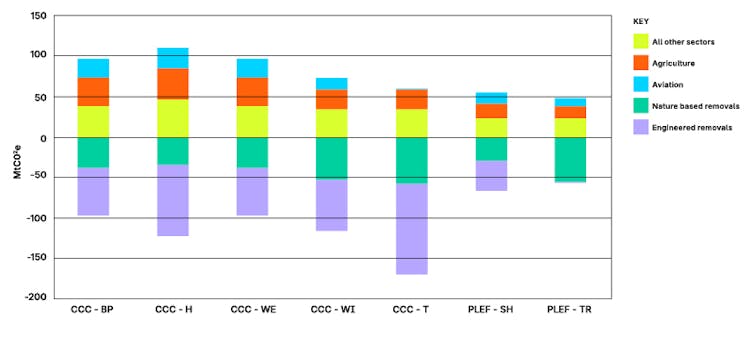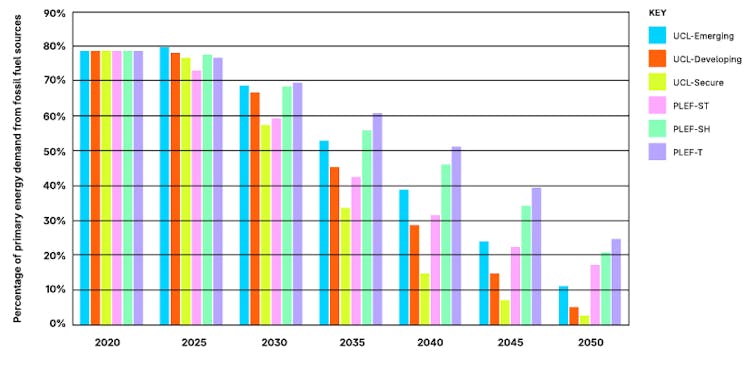
The UK is not on track to meet its climate targets and has no credible pathway to get there. However, a new set of more specific targets would provide some clarity for the country’s new government and would ultimately help achieve the overall goal: prevent further climate change.
I contributed to a new report by the Climate Evidence Unit at the University of Leeds in which we suggest four additional climate targets.
1. Emit no more than 50 million tonnes annually by 2050
It might surprise you to learn that the UK has no target for how much greenhouse gas it emits through to 2050. Instead, it has a target of “net-zero” by 2050, which looks at the balance of gas emitted into the atmosphere and removed out of it (by planting extra trees, for instance).
However, this obscures the amount of emissions that need to be cut. It allows every sector to claim that they can continue emitting because their activities will be covered by the removal of carbon elsewhere.
The problem is, it will remain very difficult to remove large amounts of CO₂ from the atmosphere. Residual emissions will therefore need to be as low as possible.
Advisory groups like the UK’s official Climate Change Committee (CCC) have mapped out various “scenarios” which show how much greenhouse gas the UK could emit while still achieving net zero by 2050, depending on how much is also removed. The higher the emissions, the more carbon removal is required. These scenarios aren’t predictions and are certainly not the only possible futures – the point is that they are consistent and credible paths the UK might take to net zero.
The chart below shows seven of these net zero scenarios. The areas above the zero line show what could still be emitted each year by 2050, mostly from sectors that are really difficult to get to zero like aviation, shipping and agriculture. The areas below the line represent the carbon removals that will be necessary to balance out those remaining emissions.
The first five scenarios are all from the CCC, while the last two – the Positive Low Energy Futures (PLEF) “shift” and “transform” scenarios – were developed by a group of academics I was part of.
UK decarbonisation scenarios:

You can see how any failure to reduce emissions will have to be compensated for by more removals. For instance, in the CCC’s “balanced pathway” scenario, annual emissions remain at just under 100 million tonnes, with a similar amount of carbon removal. (For comparison, the UK’s total greenhouse gas emissions in 2023 were 384 million tonnes.) In the CCC’s “widespread innovation” and “tailwind” scenarios, new technologies mean emissions from agriculture and aviation are smaller while more carbon is removed from the atmosphere.
But the UK can be more ambitious than that. The PLEF scenarios I worked on show there is a credible pathway for the UK to reduce greenhouse gas emissions to around 50 million tonnes. This would be an appropriate target.
2. Remove 50 million tonnes of carbon each year
The UK also has no target for the total tonnes of carbon dioxide it will need to remove from the atmosphere, despite it being integral to its net zero strategy.
Carbon removal involves either “nature-based solutions” like planting trees, or machines that suck out carbon dioxide from the atmosphere, technically known as direct air carbon capture and sequestration. Relying on these machines (the purple area in the above chart) is especially risky as they are unproven at the necessary scale.
Nonetheless, ensuring net zero is achieved means the 2050 carbon removal target must be the same as the 2050 residual emission target: 50 million tonnes per year.
3. Reduce energy demand by a minimum of 40%
Energy efficiency savings contributed to more than half of the UK’s emissions reductions between 1990 and 2019. That’s more than three times the emissions the UK has saved from switching much of its electricity generation from fossil fuels to renewables.
Yet energy demand was given little attention in the government’s net-zero strategy and the UK still does not have a target to reduce it.
The below graph shows the total reduction in energy demand by 2050 in the same scenarios as above.
Reduction in energy demand by 2050 (2020 baseline) in seven UK decarbonisation scenarios:

There is considerable evidence to show that the UK could halve its energy demand without compromising the quality of life of its citizens. Nearly all scenarios above show that energy demand must reduce by over 40% to have a reasonable chance of meeting the UK’s net zero 2050 goal.
4. Less than 10% of primary energy from fossil fuels by 2050
Ultimately, greenhouse gas emissions will be determined by the country’s level of fossil fuel burning, and the UK does not have a specific target. Of those 384 million tonnes it emitted last year, 303 million tonnes came from burning fossil fuels. The remainder came from things like agriculture, waste, forestry or peat bogs.
The below graph shows the decline in fossil fuels in a number of key scenarios for the UK. While there are other UK decarbonisation scenarios available, these do show a reasonable range of possibilities.
Energy from fossil fuels in various scenarios:

In these scenarios, the energy supplied by fossil fuels ranges from 57% to 69% by 2030, and is lowered to between 3% and 24% by 2050. The UK should aim for the more ambitious scenarios and ensure that less than 10% of primary energy comes from fossil fuels by 2050.
The new UK government needs to achieve its own legally binding goal of net zero by 2050. Reporting on these four targets would provide further clarity on how it will get there.

Don’t have time to read about climate change as much as you’d like?
Get a weekly roundup in your inbox instead. Every Wednesday, The Conversation’s environment editor writes Imagine, a short email that goes a little deeper into just one climate issue. Join the 30,000+ readers who’ve subscribed so far.
John Barrett receives funding from UK Research and Innovation (UKRI) and Research England.
This article was originally published on The Conversation. Read the original article.







